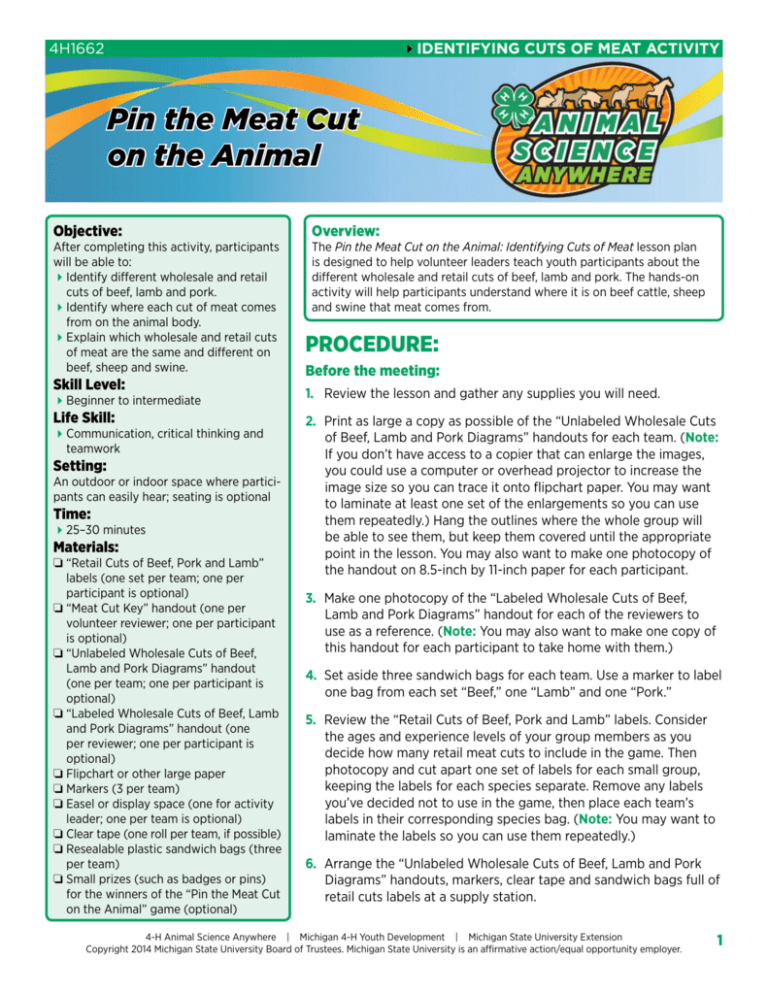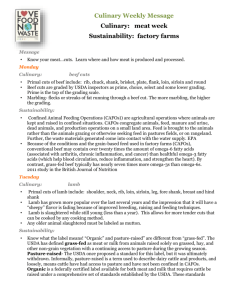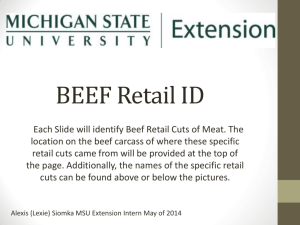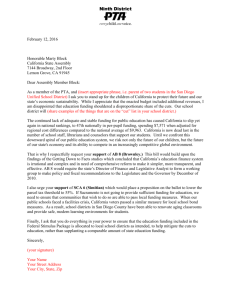
4IDENTIFYING CUTS OF MEAT ACTIVITY
4H1662
Pin the Meat Cut
on the Animal
Objective:
After completing this activity, participants
will be able to:
Identify
different wholesale and retail
cuts of beef, lamb and pork.
Identify
where each cut of meat comes
from on the animal body.
Explain
which wholesale and retail cuts
of meat are the same and different on
beef, sheep and swine.
Skill Level:
Beginner
to intermediate
Life Skill:
Communication,
critical thinking and
teamwork
Setting:
An outdoor or indoor space where participants can easily hear; seating is optional
Time:
25–30
minutes
Materials:
❏❏ “Retail Cuts of Beef, Pork and Lamb”
labels (one set per team; one per
participant is optional)
❏❏ “Meat Cut Key” handout (one per
volunteer reviewer; one per participant
is optional)
❏❏“Unlabeled Wholesale Cuts of Beef,
Lamb and Pork Diagrams” handout
(one per team; one per participant is
optional)
❏❏ “Labeled Wholesale Cuts of Beef, Lamb
and Pork Diagrams” handout (one
per reviewer; one per participant is
optional)
❏❏ Flipchart or other large paper
❏❏ Markers (3 per team)
❏❏ Easel or display space (one for activity
leader; one per team is optional)
❏❏ Clear tape (one roll per team, if possible)
❏❏ Resealable plastic sandwich bags (three
per team)
❏❏ Small prizes (such as badges or pins)
for the winners of the “Pin the Meat Cut
on the Animal” game (optional)
Overview:
The Pin the Meat Cut on the Animal: Identifying Cuts of Meat lesson plan
is designed to help volunteer leaders teach youth participants about the
different wholesale and retail cuts of beef, lamb and pork. The hands-on
activity will help participants understand where it is on beef cattle, sheep
and swine that meat comes from.
PROCEDURE:
Before the meeting:
1. Review the lesson and gather any supplies you will need.
2. Print as large a copy as possible of the “Unlabeled Wholesale Cuts
of Beef, Lamb and Pork Diagrams” handouts for each team. (Note:
If you don’t have access to a copier that can enlarge the images,
you could use a computer or overhead projector to increase the
image size so you can trace it onto flipchart paper. You may want
to laminate at least one set of the enlargements so you can use
them repeatedly.) Hang the outlines where the whole group will
be able to see them, but keep them covered until the appropriate
point in the lesson. You may also want to make one photocopy of
the handout on 8.5-inch by 11-inch paper for each participant.
3. Make one photocopy of the “Labeled Wholesale Cuts of Beef,
Lamb and Pork Diagrams” handout for each of the reviewers to
use as a reference. (Note: You may also want to make one copy of
this handout for each participant to take home with them.)
4. Set aside three sandwich bags for each team. Use a marker to label
one bag from each set “Beef,” one “Lamb” and one “Pork.”
5. Review the “Retail Cuts of Beef, Pork and Lamb” labels. Consider
the ages and experience levels of your group members as you
decide how many retail meat cuts to include in the game. Then
photocopy and cut apart one set of labels for each small group,
keeping the labels for each species separate. Remove any labels
you’ve decided not to use in the game, then place each team’s
labels in their corresponding species bag. (Note: You may want to
laminate the labels so you can use them repeatedly.)
6. Arrange the “Unlabeled Wholesale Cuts of Beef, Lamb and Pork
Diagrams” handouts, markers, clear tape and sandwich bags full of
retail cuts labels at a supply station.
4-H Animal Science Anywhere | Michigan 4-H Youth Development | Michigan State University Extension
Copyright 2014 Michigan State University Board of Trustees. Michigan State University is an affirmative action/equal opportunity employer.
1
4IDENTIFYING CUTS OF MEAT ACTIVITY
Naming the Animal & the Cut of Meat
What to call market animals and the meat that comes from them can be confusing to young people and
newcomers to the agriculture industry. This chart may help you explain how the names are used.
Market animal name
Meat name
Latinized group name
Beef, beef cattle, steer, heifer, cow, bull
Beef
Bovine
Sheep, ewe, lamb, ram, whether (immature animal)
Lamb
Ovine
Sheep, ewe, ram, whether (mature animal)
Mutton
Ovine
Hog, pig, swine, gilt, boar, barrow, sow
Pork
Porcine
7. Recreate the table that follows on flipchart paper so the participants can refer to it as they’re labeling their “Wholesale Cuts of
Beef, Lamb and Pork Diagrams” handouts. Display the paper where
the whole group will be able to see it, but keep it covered until the
appropriate point in the lesson. (Note: If you have a large group
or the teams will be spread out over a large area, you may want to
make several large copies of the table, or make one photocopy of
it per team.)
Wholesale
Beef Cuts
Wholesale
Lamb Cuts
Wholesale
Pork Cuts
Brisket
Breast
Boston butt
Chuck
Leg
Ham
Flank and short plate Loin
Loin
Fore shank
Rack
Picnic shoulder
Rib
Shoulder
Side
Round
Various*
Various*
Short loin
Sirloin
Various*
*This label is used in the national meat industry to indicate meat that comes from
various parts of the animal, rather than from a particular section of the animal.
8. Recruit one or more teen or adult volunteers who will review the
teams’ labeled handouts for accuracy. Give each reviewer a copy
of the “Labeled Wholesale Cuts of Beef, Lamb and Pork Diagrams”
and the “Meat Cut Key” handouts to use as guides.
Tell them that in the first phase of the activity their job will be to
directly help the teams correct any problems with their labeling of
the wholesale cuts of meat. In the second phase, they’ll be more
hands-off. That is, they should tell the teams how many errors
(missing or misplaced retail cuts labels) they’ve made, but not what
the errors are (unless a team is really struggling, then it’s okay to
offer them direct help).
2
4-H Animal Science Anywhere | Michigan 4-H Youth Development | Michigan State University Extension
Copyright 2014 Michigan State University Board of Trustees. Michigan State University is an affirmative action/equal opportunity employer.
4IDENTIFYING CUTS OF MEAT ACTIVITY
During the meeting:
1. Read aloud or paraphrase the following:
Almost everything we eat comes from either plants or animals.
Today we’re going to focus on which parts of beef cattle, sheep and
swine we commonly turn into food, and which cuts of meat come
from each of those parts.
2. Now ask the participants the following questions. You may want
to record their answers on flipchart paper and display the paper
where everyone can see it.
Why is it important for people to know where our food comes
from? (So we know whether our food is safe and healthy for us to
eat. So we know whether the animals it came from were treated
well. So we know about and appreciate the work that went into
producing the food. So we know why farming and farmers are
important even to people who live in town. So we can learn
about the economic impact of agriculture.)
What parts of beef cattle, sheep and swine do the meat and
meat products we eat come from? (From all over the animal.)
What are wholesale cuts? (Large sections of an animal carcass
that are divided up roughly following the animal’s bone structure.
Some parts of the carcass are more popular and scarcer, and
therefore more valuable, than others, which can also influence
how the carcass is divided into wholesale cuts.)
What are retail cuts? (Wholesale cuts that are divided into more
consumer-ready products such as steaks, chops and roasts.)
3. Read aloud or paraphrase the following:
Many wholesale cuts, which are sometimes called “primal cuts,” are
similar in beef cattle, sheep and swine, but each species also has
some unique wholesale cuts. Wholesale cuts are divided roughly
following the animal’s bone structure. Consumers tend to prefer
the flavor, tenderness and texture of some cuts over others, and
these popular cuts come from relatively small areas of the animal,
so they’re somewhat scarce. These factors combine to drive up the
wholesale and retail cost of those cuts.
4. Uncover and review with the group the flipchart paper with
the lists of wholesale cuts of beef, lamb and pork. Answer any
questions they may have about the lists.
5. Divide the group into teams of about six people, depending on the
size of your group and how many sets of supplies you’ve prepared.
Ask for a volunteer from each team to collect a set of “Unlabeled
Wholesale Cuts of Beef, Lamb and Pork Diagrams” handouts and a
marker. Then read aloud or paraphrase the following:
Next, when I say “go,” your team will have about 5 minutes to
label the outlines of a beef, sheep and swine to show where the
4-H Animal Science Anywhere | Michigan 4-H Youth Development | Michigan State University Extension
Copyright 2014 Michigan State University Board of Trustees. Michigan State University is an affirmative action/equal opportunity employer.
3
4IDENTIFYING CUTS OF MEAT ACTIVITY
TALKING IT OVER:
Answer any questions the group may
have, then ask them the following
processing questions.
What was hard about identifying
the part of the animal that each
wholesale cut of meat comes from?
What was easy about it?
Were there particular wholesale or
retail cuts of meat that you were
unfamiliar with and had trouble
identifying? Cuts from a particular
species? What made them
challenging?
In what ways does knowing where
meat cuts come from help you in
and outside of the show ring?
How does the way the animal was
raised and worked with before
arriving at the slaughter plant
affect the quality of the meat from
that animal? (Rough handling may
increase the number of dark cuts
[with blemishes such as bruises,
cuts and scrapes] that would
lower the quality of the meat.
Additionally, fear of humans can
cause an animal to panic and harm
itself, other animals or humans. If an
animal is handled calmly in a quiet
environment, the level of stress
hormones [such as cortisone and
adrenaline] in its body will stay low.
The animal should also be easier to
handle and move more easily and
quietly through the facility.)
wholesale cuts come from on each species. It’s okay to use the list
of wholesale cuts that we just went over to help you remember
each cut.
Once your team agrees that all three animal outlines are labeled
correctly, put your hands on your head. When I see that, I’ll send a
reviewer over to check to see that all of the labels are in the right
places. If they are, great! You’re done with this part. If they’re not,
the reviewer will work with you to fix any problems.
6. After about 5 minutes, or when the reviewers indicate that the
teams have successfully finished labeling the outlines, ask for
another volunteer from each team to collect a set of “Retail Cuts
of Beef, Lamb and Pork” labels and a roll of tape. Tell them to keep
the bags closed for now.
7. Read or paraphrase the following:
Now we’re going to play a game called “Pin the Meat Cut on the
Animal.” This is a race to see which team will be the first to pin
(well, really, to tape) the retail cuts of meat in the right wholesale
cut area for all three species. Each team has three bags, labeled
“Beef,” “Lamb” and “Pork.” Those bags contain labels for the
retail cuts of meat of each species. When I say “go,” you may
open the bags and start taping the labels to the right places on the
diagrams. (Be sure to tape the labels down lightly so you can move
them if you have to.)
When your team is done, hands on head again, then somebody will
come around and check your labels. If your team is the first one
done and your labels are in the right places, you’ll be the winners!
If you have any errors, the reviewer will tell you how many there
are, but not what they are. It’ll be up to your team to find and fix
the errors.
8. Keep track of the order in which the teams finished, but don’t stop
the other teams from finishing after the first team has signaled
they’re done labeling. Have the reviewers use the “Meat Cut
Key” handout to check on the accuracy of each team’s labeling.
The winner will be the team that finished first and had all three
diagrams labeled correctly. Once you’ve declared a winner, have
the members of that team go around and help any other teams
that are still working.
9. End the game once all of the teams have made a good effort to
complete the diagrams and one or more groups have labeled all
three species accurately. You may want to pass out copies of the
“Meat Cut Key” handout and have the winning team go over their
diagrams with the rest of the group.
4
4-H Animal Science Anywhere | Michigan 4-H Youth Development | Michigan State University Extension
Copyright 2014 Michigan State University Board of Trustees. Michigan State University is an affirmative action/equal opportunity employer.
4IDENTIFYING CUTS OF MEAT ACTIVITY
ADAPTATIONS & EXTENSIONS:
For species-specific clubs or groups, use only the diagrams and
labels related to the particular species.
Couple this activity with the 4-H Animal Science Anywhere lesson
plan called “Sculpting Meat Science: Creating and Evaluating
Steaks” as a second lesson relating to meat science.
For older or more experienced participants:
• Increase the challenge by scrambling the retail cuts labels for
all three species in the same bag so the teams have to decide
which species the cut comes from before deciding where on the
animal it comes from.
• Have the participants contact species associations such as the
Cattlemen’s Beef Promotion and Research Board (beefboard.
org), the American Lamb Board (www.americanlamb.com) and
the National Pork Producers Council (www.nppc.org) to find out
about additional retail cuts of meat for each species.
• Have the participants contact species associations to obtain
charts and diagrams they can use to identify additional cuts for
each species.
• Draw the outline of a market animal with the major bones
included. This can help participants see how the arrangement
of the bones affects the shape of various cuts of meat. Lead a
group discussion about how bones are a factor in the process of
harvesting an animal and separating individual cuts of meat. Use
information from the 4-H Animal Science Anywhere lesson plan
called “Locating Common Bones” to help guide the discussion.
For younger or less experienced participants:
• Group the cuts of meat together depending on where they’re
found on the animal. Have the participants decide where each
set of meat cuts comes from instead of each individual cut.
• Use only the labels for the most familiar retail cuts of meat in
the “Pin the Meat Cut on the Animal” game.
• Only use the label for one retail cut for each wholesale cut to
change “Pin the Meat Cut on the Animal” into a matching game.
REFERENCES & RESOURCES:
American Angus Association. (2007). Angus beef chart. St. Joseph, MO:
Author. Retrieved from www.angus.org/pub/beefchart.pdf
American Lamb Board. (2014). American lamb cuts. Denver, CO: Author.
Retrieved from www.americanlamb.com/lamb-101/cuts/
American Meat Science Association. (1997–2011). National 4-H meat judging
[web page]. Champaign, IL. Retrieved from meatscience.org/page.
aspx?id=466
National Pork Board. (2011). Pork basics. Des Moines, IA: Author. Retrieved
from porkandhealth.org/filelibrary/PorkAndHealth/PorkBasicsCutsChart.pdf
ACKNOWLEDGMENTS:
Authors:
Juliana Forbush, Intern, Michigan
State University Extension
Julie Thelen, 4-H Livestock and
Veterinary Science Educator, Michigan
State University Extension
This bulletin was produced by ANR
Communications (anrcom.msu.edu)
msue.anr.msu.edu
Pin the Meat Cut on the Animal © 2014 by Michigan
State University Board of Trustees. 4-H and Cooperative Extension System groups and other nonprofit
educational groups may print up to 25 hard copies
of this material for noncommercial, educational use,
provided that attribution is given to Michigan State
University. All other rights reserved. For information, contact 4-H Youth Development, 108 Agriculture
Hall, 446 West Circle Drive, East Lansing, MI 48824.
MSU is an affirmative-action, equal-opportunity employer, committed to achieving excellence through a
diverse workforce and inclusive culture that encourages all people to reach their full potential. Michigan
State University Extension programs and materials
are open to all without regard to race, color, national
origin, gender, gender identity, religion, age, height,
weight, disability, political beliefs, sexual orientation,
marital status, family status or veteran status. Issued
in furtherance of MSU Extension work, acts of May
8 and June 30, 1914, in cooperation with the U.S.
Department of Agriculture. Thomas G. Coon, Director, MSU Extension, East Lansing, MI 48824. This
information is for educational purposes only. Reference to commercial products or trade names does not
imply endorsement by MSU Extension or bias against
those not mentioned. The 4-H Name and Emblem
have special protections from Congress, protected
by code 18 USC 707. 1P–Web–06:2014–RM/MR
4-H Animal Science Anywhere | Michigan 4-H Youth Development | Michigan State University Extension
Copyright 2014 Michigan State University Board of Trustees. Michigan State University is an affirmative action/equal opportunity employer.
5
4PIN THE MEAT CUT ON THE ANIMAL LABELS
Retail Cuts of Beef, Pork & Lamb
Print out and cut apart a set of labels for all three species for each team. You may want
to laminate the labels to make them sturdier so they last longer.
Retail Cuts of Beef
6
Arm pot-roast
Blade roast
Bottom round
rump roast
Whole brisket
Flank steak
Ground beef
Mock tender roast
Petite tender
Porterhouse steak
Ribeye roast
Ribeye steak
Round steak
Shank cross cut
Shirt steak
Short ribs
Soup bones
T-bone steak
Tenderloin steak
(filet mignon)
Tip steak
Top sirloin steak
Tri-tip roast
4-H Animal Science Anywhere | Michigan 4-H Youth Development | Michigan State University Extension
Copyright 2014 Michigan State University Board of Trustees. Michigan State University is an affirmative action/equal opportunity employer.
4PIN THE MEAT CUT ON THE ANIMAL LABELS, CONTINUED
Retail Cuts of Pork
Arm roast
Back ribs
Blade Boston
roast
Blade steak
Butterfly chops
Center rib roast
Fresh side
Ground pork
Loin chops
Pork fresh ham
center slice
Rib chops
Sausage
Sirloin chops
Sliced bacon
Smoked ham
Smoked picnic
Smoked pork
hock
Tenderloin
4-H Animal Science Anywhere | Michigan 4-H Youth Development | Michigan State University Extension
Copyright 2014 Michigan State University Board of Trustees. Michigan State University is an affirmative action/equal opportunity employer.
7
4PIN THE MEAT CUT ON THE ANIMAL LABELS, CONTINUED
Retail Cuts of Lamb
Arm chops
Blade chops
Center slice
Frenched style
roast
Leg roast
Loin chops
Loin roast
Rib chops
Rib roast
Ribs
Shank
Square cut
Sirloin chops
8
4-H Animal Science Anywhere | Michigan 4-H Youth Development | Michigan State University Extension
Copyright 2014 Michigan State University Board of Trustees. Michigan State University is an affirmative action/equal opportunity employer.
4PIN THE MEAT CUT ON THE ANIMAL HANDOUT
Meat Cut Key
The wholesale cuts of meat that are harvested
from the animal are further divided into
retail cuts for sale to consumers. A partial
list of the retail cuts from beef, lamb and
pork – separated by wholesale cut – follows.
In addition, new retail cuts of meat are
developed every year.
How Wholesale Cuts of Pork
Are Divided Into Retail Cuts
Wholesale cut
Retail cut
Boston butt
Blade Boston roast
Blade steak
Ham
Pork fresh ham center
slice
Smoked ham
Loin
Back ribs
Butterfly chops
Center rib roast
How Wholesale Cuts of Beef
Are Divided Into Retail Cuts
Loin chops
Rib chops
Wholesale cut
Retail cut
Sirloin chops
Brisket
Whole brisket
Tenderloin
Chuck
Arm pot-roast
Picnic shoulder
Blade roast
Mock tender roast
Smoked picnic
Side
Fresh side
Petite tender
Flank and short plate
Fore shank
Flank steak
Sliced bacon
Various
Sausage
Short ribs
Smoked pork hock
Shank cross cut
How Wholesale Cuts of Lamb
Are Divided Into Retail Cuts
Ribeye roast
Ribeye steak
Round
Bottom round rump
roast
Round steak
Short loin
Sirloin
Ground pork
Shirt steak
Soup bones
Rib
Wholesale cut
Retail cut
Breast
Ribs
Leg
Center slice
Tip steak
Frenched style roast
Porterhouse steak
Leg roast
T-bone steak
Sirloin chops
Tenderloin steak (filet
mignon)
Loin
Top sirloin steak
Rack
Ground beef
Loin chops
Loin roast
Tri-tip roast
Various (from all wholesale
regions)
Arm roast
Rib chops
Rib roast
Shoulder
Arm chops
Blade chops
Square cut
Various
Shank
4-H Animal Science Anywhere | Michigan 4-H Youth Development | Michigan State University Extension
Copyright 2014 Michigan State University Board of Trustees. Michigan State University is an affirmative action/equal opportunity employer.
9
4PIN THE MEAT CUT ON THE ANIMAL HANDOUT
Unlabeled Wholesale Cuts
of Beef, Lamb & Pork
Beef
10
4-H Animal Science Anywhere | Michigan 4-H Youth Development | Michigan State University Extension
Copyright 2014 Michigan State University Board of Trustees. Michigan State University is an affirmative action/equal opportunity employer.
4PIN THE MEAT CUT ON THE ANIMAL HANDOUT, CONTINUED
Lamb
4-H Animal Science Anywhere | Michigan 4-H Youth Development | Michigan State University Extension
Copyright 2014 Michigan State University Board of Trustees. Michigan State University is an affirmative action/equal opportunity employer.
11
4PIN THE MEAT CUT ON THE ANIMAL HANDOUT, CONTINUED
Pork
12
4-H Animal Science Anywhere | Michigan 4-H Youth Development | Michigan State University Extension
Copyright 2014 Michigan State University Board of Trustees. Michigan State University is an affirmative action/equal opportunity employer.
4PIN THE MEAT CUT ON THE ANIMAL HANDOUT
Labeled Wholesale Cuts
of Beef, Lamb & Pork
Chuck
Brisket
Loin
Rack
Fore
Shank
Rib
Short
Loin
Short Plate
Sirloin
Round
Flank
Wholesale
Cuts of
Beef
Shoulder
Leg
Breast
Wholesale
Cuts of
Lamb
Boston
Butt
Picnic
Shoulder
Loin
Side
Ham
Wholesale
Cuts of
Pork
4-H Animal Science Anywhere | Michigan 4-H Youth Development | Michigan State University Extension
Copyright 2014 Michigan State University Board of Trustees. Michigan State University is an affirmative action/equal opportunity employer.
13






